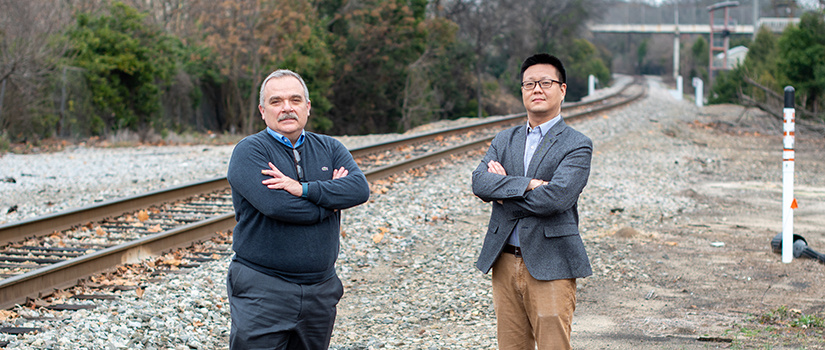And, in the process, bringing the city of Columbia to the forefront of the research.
In the United States, more than a quarter of all freight travels by railroad. The country’s rail system is an integral part of its infrastructure and economy, but in in the new millennium, it became clear that America’s railroads needed an overhaul. As reliance on the railway system grew, the gap between existing and available technology grew with it. Fortunately, researchers at the University of South Carolina have been uniquely prepared to repair this gap through their long-standing research that introduces artificial intelligence, smart technologies and novel algorithms to the railway system.
“The U.S. Department of Transportation and the Federal Railroad Administration have realized we are way behind other countries in the application of artificial intelligence in railroad practice,” says Yu Qian, an assistant professor at the University of South Carolina. “And meanwhile, the U.S. has the best artificial intelligence technology available. So, why not make the best use of that?”
For the first time, artificial intelligence and intelligent railroad infrastructure became central to federal rail-related research solicitations, and in just three years, 60 to 80 percent of the Federal Railroad Administration’s (FRA) BAA funding was going to intelligent infrastructure-related projects. It's a much-needed change, says Qian, and something that the University of South Carolina’s Advanced Railway Technology Group has been preparing for in their labs for years.
“Railway infrastructure is designed to be constructed inexpensively, but maintained frequently,” says Dimitris Rizos, an associate professor in South Carolina’s Civil and Environmental Engineering Department and founder of the rail group. “So, the projects we are targeting focus on devising innovative, inexpensive, non-destructive and non-disruptive ways to monitor the condition and performance of the infrastructure so that we can do the required maintenance in a strategic manner.”
Combining Rizos’ expertise in structural mechanics and Qian’s in transportation geotechnics, UofSC’s rail group is set to bridge the gap between the rail’s past and its upcoming future. It focuses on shifting the rail system’s maintenance from scheduled operations to condition and performance-based maintenance using non-destructive evaluation methods, smart algorithms and remote sensing. As Rizos and Qian’s work progresses, the nation’s largest federal funders are taking notice.
In just three years, the group has received grants from the FRA, Department of Transportation (DoT), Association of American Railroads and National Academy of Science. Now, it finds itself at the forefront of smart railway research and development, with over $1.8 million in active funding.
Through a $199,548 grant from the U.S. DoT and the FRA, the group is using digital image correlation (DIC) technology developed by Distinguished Professor Michael Sutton’s research group with its own smart algorithms to create a non-destructive method that identifies conditions in rail tracks that lead to tracks buckling and trains derailing.
“There has been a significant effort in the last 10-15 years to address this problem, but the problem has not yet been solved,” Rizos says. “However, our most current results are promising, and the research findings are very encouraging. We may have the solution.”
Implementing the group’s smart algorithms to improve rail assessment is feasible, thanks in large part to Sutton’s vision-based-measurement DIC technology.
“Broad expansion in the use of DIC technology is what we hoped would occur once we saw how well it worked with Boeing in the mid-’90s,” says Sutton, who was recently elected to the National Academy of Engineering for his role in the creation and dissemination of the DIC technology. “Once we saw how well it worked for complex aircraft structures, the next question was, ‘Just how far can we push this?’ Now, nearly 40 years after its conception, we no longer need to convince others of its effectiveness. It is now being used globally in ways that span many fields in engineering and science, giving us a sense of pride in what we accomplished.”
Through another DoT/FRA grant, Qian, Rizos and other UofSC faculty have paired up with Mayor Steve Benjamin and Columbia’s local city government to help the city’s first responders. Using artificial intelligence and cameras at the city’s railroad crossings, they are building a system that will alert first responders of trains blocking their route to an emergency. The group hopes that, in the future, this technology can be dispersed to the general public as well.
“It will be nice to be able to send a text message to everyone approaching a grade crossing saying, avoid this intersection for the next so-many minutes; it’s going to be blocked,” Rizos says with a smile.
Just 10 years after beginning the railroad group and making it a focus of the civil engineering department and college as a whole, Rizos and Qian are not only advancing the national rail system, but also their local city’s system. They hope the advances they are making in their lab lead to lasting changes in the world around them.
“Once these changes are in place, then you can have a smart, self-diagnosing rail infrastructure system, which would achieve infinite life and optimum operating performance at minimum costs and the highest levels of safety,” Rizos says. “Finally, America’s rail system will be at the forefront of technological innovations and maintain its prominence in the international arena.”
